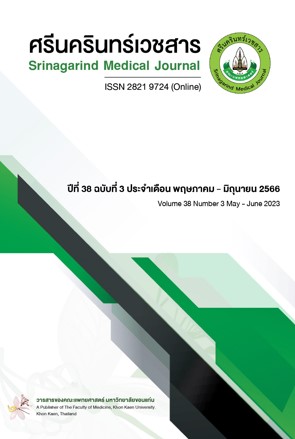หมอนรองกระดูกทับเส้นประสาทในบุคลากรทางสุขภาพห้องสวนหลอดเลือดหัวใจ: รายงานผู้ป่วย
คำสำคัญ:
หมอนรองกระดูกทับเส้น, บุคลากรทางการแพทย์, การยกของบทคัดย่อ
หลักการและวัตถุประสงค์: อาการปวดหลังส่วนล่าง พบได้บ่อยในบุคลากรทางการแพทย์ เนื่องจากการทำงานในห้องสวนหลอดเลือดหัวใจ ศูนย์หัวใจสิริกิติ์ มีการยกของหนักและบุคลากรจำเป็นต้องใส่ชุดตะกั่วกันรังสีเป็นระยะเวลานานต่อวัน จึงพบบุคลากรมีอาการปวดหลังส่วนล่างได้บ่อย และมีบุคลากรสองรายเป็นโรคหมอนรองกระดูกทับเส้นประสาท ซึ่งก่อนหน้านี้ไม่เคยมีการรายงานโรคหมอนรองกระดูกทับเส้นประสาทจากการทำงานในห้องสวนหลอดเลือดหัวใจมาก่อน จึงต้องมีการสอบสวนเพื่อวินิจฉัยการเจ็บป่วยจากการทำงานและหาแนวทางป้องกันการเกิดโรคหมอนรองกระดูกทับเส้นประสาทจากการทำงาน
วิธีการศึกษา: การศึกษาในผู้ป่วยสองรายและมีการสอบสวนโรค โดยใช้วิธีการทางระบาดวิทยาเพื่อหาปัจจัยเสี่ยงที่ทำให้เกิดโรค
ผลการศึกษา: ผู้ป่วยทั้งสองรายได้รับการวินิจฉัยเป็นหมอนรองกระดูกทับเส้นประสาท สาเหตุจากการบาดเจ็บเฉียบพลันจากการยกเครื่องจี้หัวใจและท่าทางที่ไม่เหมาะสมขณะยกและสวมใส่เสื้อตะกั่วเป็นระยะเวลานาน ผลการสอบสวนเพิ่มเติมพบว่าบุคลากรเกินครึ่งหนึ่ง (ร้อยละ 53.6) มีอาการปวดหลังจากการทำงาน
สรุป: ผู้ป่วยทั้งสองรายเป็นโรคหมอนรองกระดูกทับเส้นประสาทจากการทำงาน โดยมีปัจจัยเสี่ยงคือการยกเครื่องจี้หัวใจในท่าทางที่ไม่เหมาะสม แนวทางการป้องกันคือ มีการใช้เครื่องทุ่นแรง ให้ความรู้ท่าทางการทำงานที่ถูกต้อง และมีการเฝ้าระวังอาการปวดหลังส่วนล่างในบุคลากรอย่างต่อเนื่อง
เอกสารอ้างอิง
Ehrlich GE. Back pain. J Rheumatol Suppl 2003;67:26–31. doi.org/10.1016/B978-0-443-07201-7.50009-6
Seidler A, Bolm-Audorff U, Siol T, Henkel N, Fuchs C, Schug H, et al. Occupational risk factors for symptomatic lumbar disc herniation; a case-control study. Occup Environ Med 2003;60:821–30. doi.org/10.1136/oem.60.11.821
Beeck R op de, Hermans V. The nature of work-related low back disorders. In: Research on work-related low back disorders. Brussels: Institute for Occupational Safety and Health; 2000: 11–9.
McIntosh G, Hall H. Low back pain (acute). BMJ Clin Evid [serial on the Internet]. 2011 May 9 [cited Mar 12, 2023]; 2011:[about 35 p.]. Available from: https://kku.world/a7yuk
Tangchareonsamut J, Chaimanee A, Chongchitpaisan W. Burden of work-related low back pain in Thailand, 2017. J Prev Med Assoc Thai 2019;9:326–36.
Workmen’s Compensation Fund, Social Security Office. Occupational injuries and illnesses situation 2017-2021. Nonthaburi: The Office; 2022.
Bureau of Occupational and Environmental Diseases. Annual report 2018. Nonthaburi: The Bureau; 2018.
Keawduangdee P, Puntumetakul R, Siritaratiwat W, Boonprakob Y, Wanpen S, Rithmark P, et al. The prevalence and associated factors of working posture of low back pain in the textile occupation (fishing net) in Khon Kaen province. Srinagarind Med J 2011;26:317–24.
Seidler A, Bolm-Audorff U, Heiskel H, Henkel N, Roth-Küver B, Kaiser U, et al. The role of cumulative physical work load in lumbar spine disease: risk factors for lumbar osteochondrosis and spondylosis associated with chronic complaints. Occup Environ Med 2001;8:735–46. doi.org/10.1136/oem.58.11.735
Snook SH. Work-related low back pain: secondary intervention. J Electromyogr Kinesiol 2004;14:153–60. doi.org/10.1016/j.jelekin.2003.09.006
Seidler A, Bergmann A, Jäger M, Ellegast R, Ditchen D, Elsner G, et al. Cumulative occupational lumbar load and lumbar disc disease--results of a German multi-center case-control study (EPILIFT). BMC Musculoskelet Diso [serial on the Internet]. 2009 May 7 [cited Mar 12, 2023]; 10:[about 13 p.]. Available from: https://kku.world/e0upz doi.org/10.1186/1471-2474-10-48
Takahashi I, Kikuchi S ichi, Sato K, Sato N. Mechanical load of the lumbar spine during forward bending motion of the trunk-a biomechanical study. Spine 2006;31:18–23. doi.org/10.1097/01.brs.0000192636.69129.fb
Karahan A, Kav S, Abbasoglu A, Dogan N. Low back pain: prevalence and associated risk factors among hospital staff. J Adv Nurs 2009;65:516–24. doi.org/10.1111/j.1365-2648.2008.04905.x
Bureau of Occupational and Environmental Diseases. Manual of the risk assessment in healthcare worker. 3rd ed. Rev. ed. Nonthaburi: The Bureau; 2011. (In Thai)
Dixon RG, Khiatani V, Statler JD, Walser EM, Midia M, Miller DL, et al. Society of interventional radiology: occupational back and neck pain and the interventional radiologist. J Vasc Interv Radiol 2017;28:195–9. doi.org/10.1016/j.jvir.2016.10.017
Moore B, vanSonnenberg E, Casola G, Novelline RA. The relationship between back pain and lead apron use in radiologists. AJR Am J Roentgenol 1992;158:191–3. doi.org/10.2214/ajr.158.1.1530763
Nachemson A. The load on lumbar disks in different positions of the body. Clin Orthop Relat Res 1966;45:107–22. doi.org/10.1097/00003086-196600450-00014
Greaves WW, Das R, McKenzie JG, Sinclair DC, Hegmann KT. Work-Relatedness. J Occup Environ Med 2018;60:e640–6. doi.org/10.1097/JOM.0000000000001492
Aw T. The occupational history. In: Baxter PJ, Hunter D, Aw T, Cockcroft A, Durrington P, Harrington JM, editors. Hunter’s diseases of occupations. 10th ed. London: Hodder Arnold; 2010:31–2.
World Health Organization. Nine steps for developing a scaling-up strategy. Geneva: WHO; 2010.
National Institute for Occupational Safety and Health. NIOSH lifting equation app: NLE Calc [Internet]. 2017 [cited 2023 Mar 6]. Available from: https://kku.world/lg5zr
Bryndal A, Glowinski S, Grochulska A. Influence of occupation on the prevalence of spinal pain among physiotherapists and nurses. J Clin Med [serial on the Internet]. 2022 Sep 23 [cited Mar 12, 2023]; 11 (19):[about 14 p.]. Available from: https://kku.world/ketcy. doi.org/10.3390/jcm11195600
Notification of Ministry of Industry: Establishing industrial product standards, ergonomics, and manual material handling. Vol. 1: lifting and carrying B.E. 2554 (A.D. 2011). Roy Thai Gov Gaz 2011;128 (Special Pt 5 ng):8, 1–29.
California. Division of Occupational Safety and Health, National Institute for Occupational Safety and Health. Ergonomic guidelines for manual material handling. Cincinnati (OH): Dept. of Health and Human Services, Centers for Disease Control and Prevention, National Institute for Occupational Safety and Health; 2007.
National Institute for Occupational Safety and Health. Summary of NIOSH back belt studies [Internet]. 2013 [cited Apr 6, 2023]. Available from: https://kku.world/9hanh
Social Security Office. Guideline for the diagnosis of work-related low back pain syndrome [Internet]. 2015 [cited Mar 20,2023]. Available from: https://kku.world/a3tw5
ดาวน์โหลด
เผยแพร่แล้ว
รูปแบบการอ้างอิง
ฉบับ
ประเภทบทความ
สัญญาอนุญาต
ลิขสิทธิ์ (c) 2023 ศรีนครินทร์เวชสาร

อนุญาตภายใต้เงื่อนไข Creative Commons Attribution-NonCommercial-NoDerivatives 4.0 International License.




